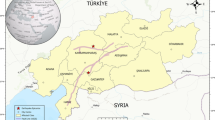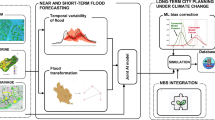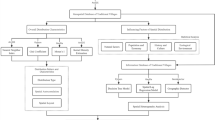Abstract
Ecotourism is one of the fastest growing sectors in the tourism industry nowadays. Ethiopia is not effectively using its rich and endemic wildlife species for ecotourism due to various physical and socioeconomic factors. Masha district has also abundant and valuable natural and cultural resources that can be developed into ecotourism, but the district was not used its attractive resources for ecotourism. The current study was initiated to select potential sites for ecotourism using Geographic Information System and Remote Sensing as a decision support tool in Masha district, Southwest Ethiopia. This study employed Geographic Information System-based Multi-Criteria Evaluation Method because it was commonly used technique in suitable site selection. To achieve the objective of this study, about even physical and socioeconomic parameters were selected through the literature review. Then, weights for each factor were assigned based on Analytical Hierarchy Process using pairwise comparison matrices. Based on the overlay result, a thematic map of potential ecotourism sites was produced. The final results reveal that about 21.2% of the study area was classified as highly suitable potential ecotourism sites whereas about 59 and 19.5% of the district were under moderately and marginally suitable classes. But, only the small portion of the district (0.4%) was considered as not currently suitable site for ecotourism. Therefore, decision-makers should give a due attention to advertise the selected suitable site for both local and foreign tourists in order to develop the district as one of the ecotourism destination areas in the country.







Similar content being viewed by others
References
Abrehe S, Girma A, Nigusse AG (2021) Potential ecotourism site suitability evaluation for sustainable natural resource management in Kafta Sheraro National Park (KSNP), north-western Tigray. Ethiopia J Ecotour 20(4):341–370
Ajibade TF, Nwogwu NA, Ajibade FO, Adelodun B, Idowu TE, Ojo AO, Iji JO, Olajire OO, Akinmusere OK (2020) Potential dam sites selection using integrated techniques of remote sensing and GIS in Imo State, Southeastern. Nigeria Sustain Water Resour Manag 6(4):1–16
Ambecha AB, Melka GA, Gemeda DO (2020) Ecotourism site suitability evaluation using geospatial technologies: a case of Andiracha district. Ethiopia Spatial Inf Res 28(5):559–568
Bakala F, Tadesse B (2018) The role of gender in potato production and marketing: case of Sheka zone. Southwest Ethiopia World J Bus Manag 4(2):16–29
Berisa G, Birhanu Y (2015) Municipal solid waste disposal site selection of Jigjiga town using GIS and remote sensing techniques, Ethiopia. Int J Sci Res Publ 5(4):17
Bunruamkaew K, Murayam Y (2011) Site suitability evaluation for ecotourism using GIS and AHP: a case study of Surat Thani province, Thailand. Procedia Soc Behav Sci 21:269–278
Central statistics authority CSA (2007) Ethiopia population and housing census report 2007. Mortality
El Maguiri A, Kissi B, Idrissi L, Souabi S (2016) Landfill site selection using GIS, remote sensing and multicriteria decision analysis: case of the city of Mohammedia, Morocco. Bull Eng Geol Env 75(3):1301–1309
El Shiaty R, Taalab M, Osama I (2016) Evaluating the performance of the outdoor spaces in healing Eco-tourism. Procedia Environ Sci 34:461–473
Fang Y (2017) Site selection of ecotourism: a case study of Zhejiang province. Int J Innov Sci, Eng Technol 4(3):321–326
FDRE C, CSA (Central Statistical Agency of Ethiopia), Csa, CSA(Central Statistical Agency), Utilization L, and CSA (Central Statstics Agency) (2009) Area and production of crops. Statistical Bulletin
Furo G, Manaye A, Negasa A (2020) Identification of spice shade and support tree species, south western Ethiopia. Agrofor Syst 94(1):95–102
Geremew YM and Gondar E (2019) Ethiopian tourism practitioners level of awareness on the tourism development policy: the missing links of Ethiopian tourism sustainability
Geremew YM, Hailemeriam LY (2015) Site Suitability evaluation of ecotourism potentials for sustainable natural resource management and community based ecotourism development : the case of bench Maji Zone, South Western part of Ethiopia. Scholars J Arts, Human Soc Sci 3(November):1368–1383
Ghavami SM (2019) Multi-criteria spatial decision support system for identifying strategic roads in disaster situations. Int J Crit Infrastruct Prot 24:23–36
Gigović L, Pamučar D, Lukić D, Marković S (2016) GIS-Fuzzy DEMATEL MCDA model for the evaluation of the sites for ecotourism development: a case study of “Dunavski ključ” region, Serbia. Land Use Policy 58:348–365
Gole TW, Ilfata FG, Tafa M, Aregachew A (2014) The marginalized and poorest in different communities and settings of Ethiopia. Marginality, 365
Hwang CL and Yoon K (1981) Methods for multiple attribute decision making. In: Multiple attribute decision making (pp 58–191). Springer, Berlin, Heidelberg
Islam MR, Ahmad MR, Alam MN, Marma MS, Gafur A (2020) Micro-watershed delineation and potential site selection for runoff water harvesting using remote sensing and GIS in a hilly area of Bangladesh. Am J Water Resour 8(3):134–144
Kelly J, Williams P (2007) Tourism destination water management strategies: an eco-efficiency modelling approach. Leisure/loisir 31(2):427–452
Kiavarz H, Jadidi M, Rajabifard A, Sohn G (2018) BIM-GIS oriented intelligent knowledge discovery. Int Archiv Photogramm Remote Sens Spatial Inf Sci 42:79–82
Liu M, Wang S (2017) Method for evaluating the eco-tourism environmental carrying capacity with hesitant fuzzy linguistic information. J Intell Fuzzy Syst 33(3):1733–1740
Mahdavi A, Niknejad M (2014) Site suitability evaluation for ecotourism using MCDM methods and GIS: case study-Lorestan province. Iran J Biodiver Environ Sci 4(6):425–437
Mekonnen G, Woldesenbet M, Kassa G (2018) Assessment of weed flora composition in arable fields of Bench Maji, Keffa and Sheka Zones, South West Ethiopia. Agric Res Technol 14:01–08
Mondino E, Beery T (2019) Ecotourism as a learning tool for sustainable development. The case of Monviso Transboundary Biosphere Reserve Italy. J Ecotour 18(2):107–121
Ng’ang’a TM, Muturi WP, Wangai KJ, Joash W, Matheri N (2014) Solid waste dumping site selection using GIS and remote sensing for Kajiado county, Kenya. J Earth Sci Eng 10(4):597–604
Okot P, Ogao PJ, Abandu J (2019) Site selection model for urban solid waste disposal management using GIS and remote sensing: a case of Gulu Municipality. Int J Environ Waste Manage 24(4):405–436
Pareta K (2013) Remote sensing and GIS based site suitability analysis for tourism development. Int J Adv Res Eng Appl Sci 2(5):43–58
Patanè G, Spagnuolo M (2016) Heterogeneous spatial data: fusion, modeling, and analysis for GIS applications. Synthesis Lectures on vis Comput Comput Graph, Animat, Comput Photogr, Imag 8(2):1–155
Poorna CA, Vinod PG (2016) Solid waste disposal site selection by data analysis using GIS and remote sensing tools: a case study in Thiruvananthapuram corporation area. Int J Geomat Geosci 6(4):1734–1747
Saaty TL (1980) The Analytic hierarchy process: planning, priority setting, resources allocation. Mcgraw-Hill, New York
Sadeghi-Niaraki A, Kim K, Varshosaz M (2010) Multi-criteria decision-based model for road network process. Int J Environ Res 4(4):573–582
Saidi S, Hosni S, Mannai H, Jelassi F, Bouri S, Anselme B (2017) GIS-based multi-criteria analysis and vulnerability method for the potential groundwater recharge delineation, case study of Manouba phreatic aquifer. NE Tunisia Environ Earth Sci 76(15):1–20
Salman A, Jaafar M, Mohamad D (2020) A comprehensive review of the role of Ecotourism in sustainable tourism development. e-Rev Tour Res 18(2):215–233
Samanta S, Baitalik A (2015) Potential site selection for eco-tourism: a case study of four blocks in Bankura district using remote sensing and GIS technology, West Bengal. Int J Adv Res 3(4):978–989
Senbeta F, Woldemariam T, Demissew S, Denich M (2007) Floristic diversity and composition of Sheko forest, Southwest Ethiopia. Ethiop J Biol Sci 6(1):11–42
Şener Ş, Sener E, Karagüzel R (2011) Solid waste disposal site selection with GIS and AHP methodology: a case study in Senirkent-Uluborlu (Isparta) Basin. Turkey Environ Monitor Assess 173(1):533–554
Tadesse B, Bakala F, Mariam LW (2018) Assessment of postharvest loss along potato value chain: the case of Sheka Zone, southwest Ethiopia. Agric Food Secur 7(1):1–14
Tiberghien G (2019) Managing the planning and development of authentic eco-cultural tourism in Kazakhstan. Tour Plan Dev 16(5):494–513
Tzeng GH, Huang JJ (2011) Multiple attribute decision making: methods and applications. CRC Press
UNWTO tourism highlights, 2016 Edition (2016) In: UNWTO Tourism Highlights, 2016 Edition. https://doi.org/10.18111/9789284418145
UNWTO (2014) Global report on adventure tourism. World Tourism Organization
Van Opstal M, Oosterlynck B, Belay M, Erens J, De Beenhouwer M (2019) First assessment of bird diversity in the UNESCO Sheka Forest Biosphere Reserve, southwestern Ethiopia: species richness, distribution and potential for avian conservation. J Threat Taxa 11(7):13850–13867
Woldu MG (2018) Community based tourism in Lake Tana growth corridor of the Amhara region of Ethiopia: the missing link among stakeholders and implications to tourism industry. Cogent Soc Sci 4(1):1450335
Yuwono E, Illa Maulany RISMA and Abarkey ROLAND (2021) Site suitability evaluation for ecotourism development: a case study in Bulue Village, Soppeng District, Indonesia. J Sustain Sci Manag
Acknowledgements
We would like to thank Jimma University and Masha district for their immense contribution during data collection and investigation process.
Funding
This research did not receive any specific grant from funding agencies in the public, commercial, or not-for-profit sectors.
Author information
Authors and Affiliations
Contributions
All authors contributed to the study conception and design. Material design, data collection, and analysis were performed by AA and KG. The first draft of the manuscript was written by AA, and KG, AM, and TM commented on the previous versions of the manuscript. All authors read and approved the final manuscript.
Corresponding author
Ethics declarations
Conflict of interest
The authors declare that they have no competing interests.
Ethical approval
This article does not contain any studies with human participants or animals performed by any of the authors.
Consent of publish
We authors accept and confirm responsibility for releasing this material on behalf of any and all co-authors.
Additional information
Editorial responsibility: S. Mirkia.
Rights and permissions
Springer Nature or its licensor (e.g. a society or other partner) holds exclusive rights to this article under a publishing agreement with the author(s) or other rightsholder(s); author self-archiving of the accepted manuscript version of this article is solely governed by the terms of such publishing agreement and applicable law.
About this article
Cite this article
Andemo, A., Getahun, K., Melese, A. et al. Application of geospatial technology for potential ecotourism site selection in Masha district, Southwest Ethiopia. Int. J. Environ. Sci. Technol. 21, 5019–5034 (2024). https://doi.org/10.1007/s13762-023-05342-5
Received:
Revised:
Accepted:
Published:
Issue Date:
DOI: https://doi.org/10.1007/s13762-023-05342-5




